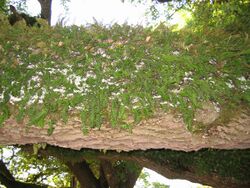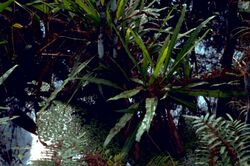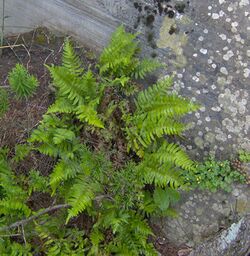Biology:Polypodiaceae
| Polypodiaceae | |
|---|---|

| |
| Pleopeltis polypodioides fronds on an oak limb | |
| Scientific classification Error creating thumbnail: Unable to save thumbnail to destination
| |
| Kingdom: | Plantae |
| Clade: | Tracheophytes |
| Division: | Polypodiophyta |
| Class: | Polypodiopsida |
| Order: | Polypodiales |
| Suborder: | Polypodiineae |
| Family: | Polypodiaceae |
| Subfamilies and genera | |
|
See text. | |
| Synonyms | |
| |
Polypodiaceae is a family of ferns. In the Pteridophyte Phylogeny Group classification of 2016 (PPG I), the family includes around 65 genera and an estimated 1,650 species and is placed in the order Polypodiales, suborder Polypodiineae.[1] A broader circumscription has also been used, in which the family includes other families kept separate in PPG I. Nearly all species are epiphytes, but some are terrestrial.[2]
Description
Stems of Polypodiaceae range from erect to long-creeping. The fronds are entire, pinnatifid, or variously forked or pinnate. The petioles lack stipules. The scaly rhizomes are generally creeping in nature. Polypodiaceae species are found in wet climates, most commonly in rain forests. In temperate zones, most species tend to be epiphytic or epipetric.[2]
Notable examples of ferns in this family include the resurrection fern (Pleopeltis polypodioides) and the golden serpent fern (Phlebodium aureum).[2]
Taxonomy
Two distinct circumscriptions of the family are in use. The Pteridophyte Phylogeny Group classification of 2016 (PPG I) uses a circumscription of Polypodiaceae in which the family is placed in the suborder Polypodiineae (eupolypods I), along with eight other families. The relationship between the families is shown in the consensus cladogram below.[1]
An alternative approach treats the suborder Polypodiineae as the family Polypodiaceae sensu lato, and reduces the families to subfamilies, so that the Polypodiaceae sensu stricto becomes the subfamily Polypodioideae.[3] The broader circumscription is used by Plants of the World Online, (As of August 2019); for example, the Dryopteridaceae, shown above as a separate family, is included in its Polypodiaceae.[4] The broadly defined Polypodiaceae has been described as an "unwieldy megafamily".[5]
Subfamilies
Molecular phylogenetic analysis has led to the division of the Polypodiaceae into six subfamilies, and to the inclusion of genera that have at various times been placed in other families, including the Drynariaceae, Grammitidaceae, Gymnogrammitidaceae, Loxogrammaceae, Platyceriaceae, and Pleurisoriopsidaceae.[1][6] The following cladogram shows a possible phylogenetic relationship between the subfamilies based on an analysis published in 2008; at the time, Grammitidoideae was not separated from Polypodioideae.[7][8]
| Polypodiaceae |
| ||||||||||||||||||||||||||||||||||||||||||||||||||||||||||||||||||||||||
The subfamilies are treated as tribes in other systems. Mabberley, in 2008, treated all of Polypodiaceae except for the Platycerioideae (Platycerium and Pyrrosia) and the grammitid ferns, which he placed in Grammitidaceae, as the subfamily Polypodioideae, which he then divided into six tribes, four of which correspond to PPG I subfamilies (Drynarieae, Loxogrammeae, Microsoreae and Polypodieae) and others of which have been submerged (Selligueeae, now within Drynarioideae, and Lepisoreae, now within Microsoroideae).[9] Other systems also treat the subfamilies as tribes.[3] The equivalence is shown in the following table.
| PPG I[1] | Christenhusz & Chase (2014)[3] |
|---|---|
| Family Polypodiaceae J.Presl & C.Presl | Subfamily Polypodioideae B.K.Nayar |
| Subfamily Loxogrammoideae H.Schneid. | Tribe Loxogrammeae R.M.Tryon & A.F.Tryon |
| Subfamily Platycerioideae B.K.Nayar | Tribe Platycerieae Christenh. |
| Subfamily Drynarioideae Crabbe, Jermy & Mickel | Tribe Drynarieae Chandra |
| Subfamily Microsoroideae B.K.Nayar | Tribe Microsoreae V.N.Tu |
| Subfamily Polypodioideae Sweet | Tribe Polypodieae Hook. & Lindl. ex Duby |
| Subfamily Grammitidoideae Parris & Sundue |
Genera
In the list that follows, the taxa shown with the "(=)" prefix are considered to be synonyms for the accepted subfamily name that they follow. However, this does not necessarily imply that the subfamily contains all of the synonym's previous genera.[1][6]
| Phylogeny of Polypodiaceae[10][11] | ||||||||||||||||||||||||||||||||||||||||||||||||||||||||||||||||||||||||||||||||||||||||||||||||||||||||||||||||||||||||||||||||||||||||||||||||||||||||||||||||||||||||||||||
|
- Subfamily Adetogrammoideae Zhang & Wei
- Adetogramma Almeida
- Subfamily Campyloneuroideae Zhang & Wei
- Campyloneurum C.Presl
- Microgramma C.Presl
- Niphidium J.Sm.
- Subfamily Drynarioideae Crabbe, Jermy & Mickel (Drynarieae Subh.Chandra; Selligueeae Hennipman[9]; Aglaomorpheae Chandra; Crypsinoideae Nayar)
- Drynaria (Bory 1825) Smith [Aglaomorpha]
- Pichisermollodes Fraser-Jenk. & Challis.
- Selliguea Bory [Arthromeris; Gymnogrammitis; Paraselliguea; Polypodiopteris]
- ×Sellimeris Fraser-Jenkins, Singh & Fraser-Jenkins
- Synammia C.Presl
- Subfamily Grammitidoideae Parris & Sundue [Grammitideae Presl; Mecosoreae Klotzsch; Pleurogrammeae Fée ex Pfeiffer]
- Acrosorus Copel.
- Adenophorus Gaudich.
- Alansmia M.Kessler, Moguel, Sundue & Labiak
- Archigrammitis Parris
- Ascogrammitis Sundue
- Calymmodon C.Presl
- Ceradenia L.E.Bishop
- Chrysogrammitis Parris
- Cochlidium Kaulf. [Xiphopteris Kaulfuss]
- Ctenopterella Parris
- Dasygrammitis Parris
- Enterosora Baker [Zygophlebia L.E.Bishop]
- Galactodenia Sundue & Labiak
- Grammitis Sw.
- Lellingeria A.R.Sm. & R.C.Moran
- Leucotrichum Labiak
- Lomaphlebia J.Sm.
- Luisma M.T.Murillo & A.R.Sm.
- Melpomene A.R.Sm. & R.C.Moran
- Micropolypodium Hayata
- Moranopteris R.Y.Hirai & J.Prado
- Mycopteris Sundue
- Notogrammitis Parris
- Oreogrammitis Copel. [Radiogrammitis Parris; Themelium (T.Moore) Parris]
- Parrisia Shalisko & Sundue
- Prosaptia C.Presl [Ctenopteris Blume ex Kunze non Brongniart ex de Saporta non Newman]
- Scleroglossum Alderw. [Nematopteris van Alderwerelt van Rosenburgh]
- Stenogrammitis Labiak
- Terpsichore A.R.Sm.
- Tomophyllum (E.Fourn.) Parris
- Xiphopterella Parris
- Subfamily Loxogrammoideae H.Schneid. (Loxogrammeae R.M.Tryon & A.F.Tryon)
- Lacks sclerenchyma (supporting tissue) in plant body, except in the roots.[9]
- Dictymia J.Sm.
- Loxogramme (Blume) C.Presl
- Subfamily Microsoroideae B.K.Nayar (Lepisoroideae Ching; Microsoreae V.N.Tu; Lemmaphylleae Tu)
- Bosmania Testo
- Dendroconche Copel.[12]
- Ellipinema Zhang & Zhang
- Goniophlebium (Blume) C.Presl
- Lecanopteris Reinw. ex Blume
- Lemmaphyllum C.Presl
- Lepidomicrosorium Ching & K.H.Shing
- Lepisorus (J.Sm.) Ching
- Leptochilus Kaulf. [Kontumia Wu & Lôc]
- Microsorum Link [Kaulinia Nayar]
- Neocheiropteris Christ.
- Neolepisorus Ching
- Paragramma (Blume) T.Moore
- Phymatosorus Pichi-Sermolli
- Podosorus Holttum
- Thylacopteris Kunze ex J.Sm.
- Tricholepidium Ching
- Zealandia Testo
- Subfamily Platycerioideae B.K.Nayar (Platycerieae Christenhusz)
- Fronds with stellate hairs (star-shaped, radiating from center).[9]
- Hovenkampia Zhang & Zhou
- Platycerium Desv.
- Pyrrosia Mirb.
- Subfamily Polypodioideae Sweet (Polypodieae Hooker & Lindley ex Duby (sensu Mabberley 2008))
- Pecluma M.G.Price.
- Phlebodium (R.Br.) J.Sm.
- ×Phlebosia Viane & Pompe
- Pleopeltis Humb. & Bonpl. ex Willd.
- Pleurosoriopsis Fomin
- Polypodium L. Perhaps
- Subfamily Serpocauloideae Zhang & Wei
- Serpocaulon A.R.Sm.
See also
References
- ↑ 1.0 1.1 1.2 1.3 1.4 PPG I (2016). "A community-derived classification for extant lycophytes and ferns". Journal of Systematics and Evolution 54 (6): 563–603. doi:10.1111/jse.12229.
- ↑ 2.0 2.1 2.2 Panigrahi, G.; Patnaik, S.N. (1961). "Cytology of Some Genera of Polypodiaceae in Eastern India". Nature 191 (4794): 1207–1208. doi:10.1038/1911207a0. Bibcode: 1961Natur.191.1207P.
- ↑ 3.0 3.1 3.2 Christenhusz, Maarten J.M.; Chase, Mark W. (2014). "Trends and concepts in fern classification". Annals of Botany 113 (9): 571–594. doi:10.1093/aob/mct299. PMID 24532607.
- ↑ "Dryopteridaceae Herter". Plants of the World Online. Royal Botanic Gardens, Kew. https://powo.science.kew.org/taxon/urn:lsid:ipni.org:names:30014148-2.
- ↑ Sundue, Michael A.; Parris, Barbara S.; Ranker, Tom A.; Smith, Alan R.; Fujimoto, Erin L.; Zamora-Crosby, Delia; Morden, Clifford W.; Chiou, Wen-Liang et al. (2014). "Global phylogeny and biogeography of grammitid ferns (Polypodiaceae)". Molecular Phylogenetics and Evolution 81: 195–206. doi:10.1016/j.ympev.2014.08.017. PMID 25173566.
- ↑ 6.0 6.1 Christenhusz, Maarten; Zhang, Xian-Chun; Schneider, Harald (2011). "A linear sequence of extant families and genera of lycophytes and ferns". Phytotaxa 19: 7–54. doi:10.11646/phytotaxa.19.1.2. https://helda.helsinki.fi/handle/10138/28042. Retrieved 2013-08-11.
- ↑ Schuettpelz, Eric; Pryer, Kathleen M. (2008), "Fern phylogeny", in Ranker, Tom A.; Haufler, Christopher H., Biology and Evolution of Ferns and Lycophytes, Cambridge University Press, https://sites.duke.edu/pryerlab/files/2017/12/s-p-chapter15-2008.original.pdf, retrieved 2019-08-02
- ↑ Chen, Chi-Chuan; Hyvönen, Jaakko; Schneider, Harald (2020). "Exploring phylogeny of the microsoroid ferns (Polypodiaceae) based on six plastid DNA markers". Molecular Phylogenetics and Evolution 143: 106665. doi:10.1016/j.ympev.2019.106665. PMID 31704235. https://www.sciencedirect.com/science/article/abs/pii/S1055790319303902.
- ↑ 9.0 9.1 9.2 9.3 Mabberley, D.J. (2008). Mabberley's plant-book: a portable dictionary of plants, their classification and uses. Cambridge University Press. p. 690. ISBN 978-0-521-82071-4. https://books.google.com/books?id=9RyKKHtwXUYC&pg=PA690.
- ↑ Nitta, Joel H.Expression error: Unrecognized word "et". (2022). "An Open and Continuously Updated Fern Tree of Life". Frontiers in Plant Science 13: 909768. doi:10.3389/fpls.2022.909768. PMID 36092417.
- ↑ "Tree viewer: interactive visualization of FTOL". 2022. https://fernphy.github.io/viewer.html.
- ↑ Testo, Weston L.; Field, Ashley R.; Sessa, Emily B.; Sundue, Michael (2019), "Phylogenetic and Morphological Analyses Support the Resurrection of Dendroconche and the Recognition of Two New Genera in Polypodiaceae Subfamily Microsoroideae", Systematic Botany 44 (4): 737–752, doi:10.1600/036364419X15650157948607, http://sites.clas.ufl.edu/bio-sessalab/files/SysBot2019.pdf, retrieved 2020-02-11
External links
Wikidata ☰ Q849350 entry
 |







